Two Helpful, However Totally different .30-Caliber Choices

I dropped by an area gun retailer the opposite day and observed an intriguing pistol-length AR-15 behind the counter. The tag listed it as a .300 Blackout and, figuring out my son was out there for one, I requested to have a look. This prompted a remark from an older woods-wise buyer whose take was, the .300 Blackout was just about a wasted effort as a result of a .308 may produce higher outcomes with any bullets of the identical diameter.
This brings us to the subsequent large caliber debate – .300 Blackout vs .308 Winchester. These comparisons by no means die, and it’s why we’ve lined comparable matters earlier than: 9mm vs .40 and .30-30 vs .308 to call just a few.
.300 Blackout vs .308 Winchester – The Massive Debate
This man’s opinion was grounded in some logic. The .308 can certainly fireplace all of them at a lot larger velocities. However the place will we draw the road? The .30/06 will greatest a .308. The .300 Winchester Magnum will trounce ‘em all, as will the prolonged listing of different .30-magnums.
However elevated efficiency comes with prices past expense, to incorporate recoil and total dimension. Someplace, there’s a cheerful stability. The .308 hits the candy spot properly, and it presents ample energy to deal with most high-power rifle chores.
Born for the U.S. M-14 service rifle, it’s additionally an ideal match for compact sporting weapons. Nonetheless, as time marched on, just a few shortcomings appeared – none of which had been a direct fault of the superb .308 Winchester. The considerably convoluted path that exposed them led to in the present day’s .300 Blackout.
First up was adoption of the U.S. M-16; a a lot lighter successor to the M-14 that fired a smaller .223/5.56 NATO cartridge. Explosive development of the civilian AR-15 adopted, resulting in growing curiosity in additional potent calibers. No luck with the .308 although. Regardless of makes an attempt to cram the cartridge right into a platform smaller than the AR-10, it’s is simply too giant for an AR-15.
Someday later an enormous spike in suppressor curiosity developed – with a wrinkle straight associated to the AR platform: If fired in an AR-10, the .308 is tough to silence to its fullest extent, whereas sustaining dependable operate. You may spin a suppressor on the muzzle of any threaded .308 muzzle, nevertheless it’ll generate a nasty crack with customary supersonic rounds.
Watered-down subsonic hundreds are one answer, however the capacious .308 case doesn’t play nicely with small powder expenses – which additionally lack the pressures wanted to cycle autoloaders. Not that the .308 Winchester isn’t a particularly helpful cartridge; it most definitely is! The one actual fly within the ointment is the hush issue.
.308 Winchester
I lined the .308 in a comparability to the .223 Remington/.5.56 NATO. What follows is the crux of the .308 content material from that article.
The .308 relies on a shortened ’06 case. It was developed to be used in machineguns and the M-14 Rifle (a post-war evolution of the basic M-1 Garand). Being particularly appropriate for semi and full-auto techniques, the brand new .30-caliber T-65 cartridge quickly gained favor amongst different Chilly Warfare allies, culminating in its 1954 designation of seven.62 NATO. However, Winchester acknowledged its sporting potential even earlier and launched the brand new .308 Winchester to civilians in 1952.
Each cartridges are virtually equivalent, however navy chambers are reduce with a bit of additional clearance (headspace) to advertise dependable feeding in machineguns, and many others. Army rounds might also have thicker brass – a better concern for handloaders.
However, I as soon as fired a bunch of de-linked 7.62 machinegun rounds by my agency-issue Remington 26” HB M-700. Accuracy, though not sub-MOA, was ok to ring metal silhouettes past a quarter-mile.
When finalized, the navy T-65 fired a 147-grain bullet at round 2800 toes per second (fps), near the ’06 due to extra environment friendly propellants. After all, heavier bullets and/or shorter barrels will lower this velocity. The M-14 had a 22-inch barrel. My chronograph signifies muzzle velocities nearer to 2600 fps with a number of 168-grain hundreds fired by 20-inch barrels.
The outdated ’06 will greatest most .308 hundreds (significantly these with heavier bullets), however the latter remains to be loads succesful. On account of its recognition a lot effort has gone into civilian hundreds. To a lesser extent, the navy additionally adopted go well with.
In an actual sense, the .308 is a breakthrough cartridge. Its case was shortly reformed to create a collection of different new calibers from .243 Winchester to .358 Winchester, together with a number of in between. Rifle producers like Sako and Remington started providing “short-action” variations of their bolt-guns with compact receivers.
These stiffer actions, if fitted with good barrels, can ship excellent accuracy. The .308’s reasonable propellant expenses lower recoil and in addition restrict throat erosion. Most .308 barrels incorporate a 1:12 rifling-twist, which appears to stabilize a lot of bullets weighing from 110- 180 grains.
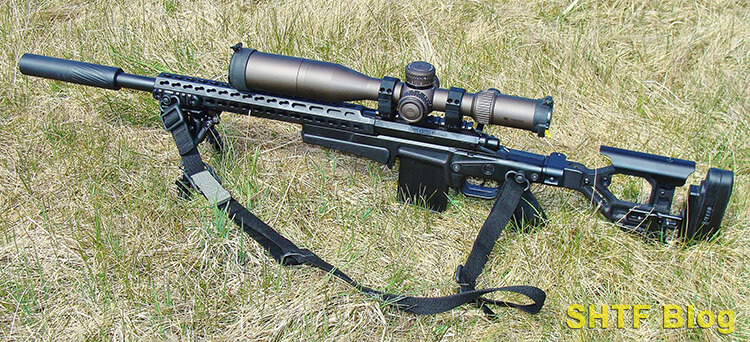
Nonetheless, rising curiosity in long-range taking pictures has led to glossy however heavier projectiles of 190 grains or extra. Thus, some barrels now use barely faster charges akin to 1:10.
Lengthy-Vary Use
The current precision-rifle mania has led to targets set at nice distances, and one end result has been a collection of latest flat-shooting cartridges. Of be aware although, the .308 remains to be provided in a lot of the heavy-barrel bolt-action fashions designed for these occasions.
Lengthy-range taking pictures is a subject all it’s personal, however the brief story is, the .308 nonetheless has attain due to in the present day’s rangefinders, ballistic apps, and trajectory-compensating scopes. Even in a primary sporting rifle, the .308 needs to be greater than enough for many of us – definitely good out to a quarter-mile. You can double that with the precise gear – and vital expertise.
Common-Goal Use
The recognition of the .308 ensures an excellent assortment of helpful looking hundreds. The light-weight 110-grain hundreds are greatest for varmints, though some are used for defensive functions. Inexpensive soft-points like Remington’s 150-grain Core-Lokts, and many others., are high-quality for whitetail deer. Some hunters in my state additionally use ‘em for moose, though they might select 180-grain variations to achieve extra penetration.
Another choice for big North American recreation is a premium load with a bullet just like the time-tested Nosler Partition, or the newer “monolithics.” The latter varieties, just like the Barnes TS-X or Hornady GMX, make use of solid-copper bullets. As a result of they mix dependable enlargement with deep penetration (and close to 100% weight retention), the 165-grain choices can equal or exceed the efficiency of most standard 180-grain bullets whereas producing much less recoil.
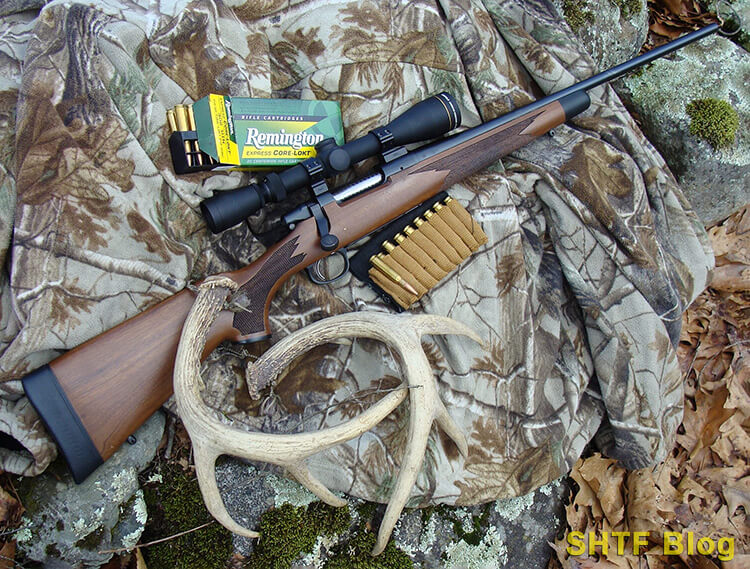
A attainable draw back of the .308 for some may very well be recoil. In comparison with a lot of different efficient cartridges it’s not extreme, however its kick will likely be noticeable. If bothersome, reduced-recoil .308 hundreds can be found with sufficient energy for deer, and many others.
Those that personal AR-10s are inclined to ship extra rounds downrange and the extra reasonably priced load for targets (not looking) is a primary FMJ in a weight just like the increasing selection. Confidently the identical zero could also be attainable.
Talking of zeroes, if a full-powered 165-grain .308 load is zeroed at 200 yards, it’ll strike round 2-inches excessive at 100 yards, and 9-inches low at 300 yards – relying on the size of the barrel. I take pleasure in ringing metal silhouettes at a lot additional distances with a 20-inch heavy-barreled Remington .308 Mannequin 700.
Its threaded muzzle will settle for a suppressor, which eliminates a lot of the growth widespread to high-power rifle cartridges. The “can” additionally reduces recoil – however the sharp supersonic crack remains to be apparent. For actually quiet taking pictures the repair is a change to a distinct system – chambered for the Blackout.
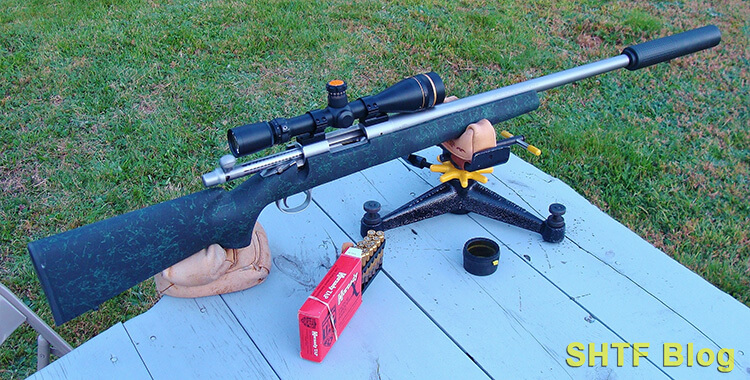
.300 Blackout
I mentioned the .300 BLK throughout a publish titled .30-Caliber AR-15 Choices. A few of the following is from that article.
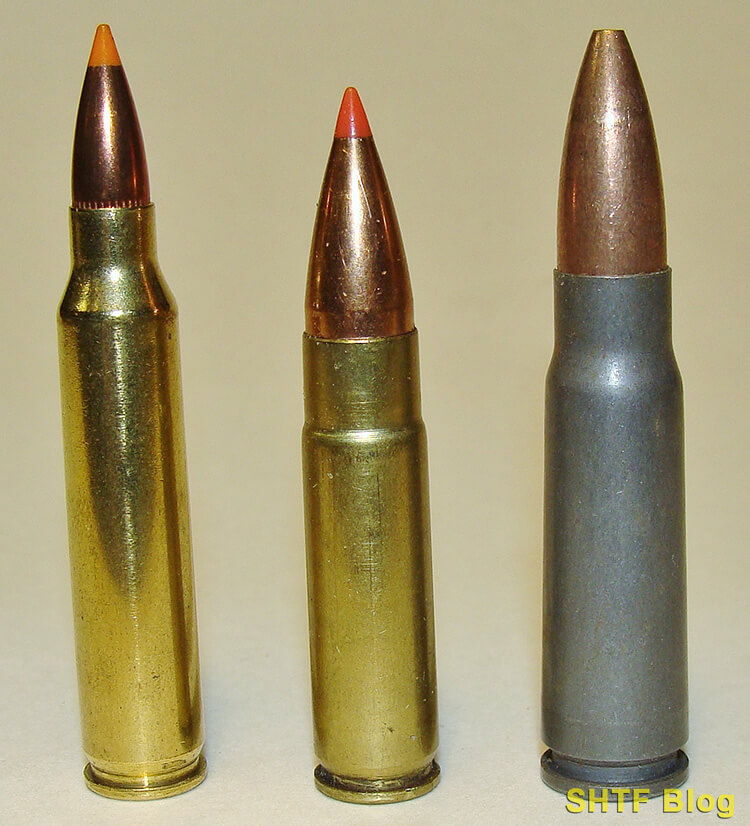
The .300 Blackout cartridge is an evolution of the older J.D. Jones-designed Whisper. You may type brass from 5.56mm/.223 instances by trimming off the shoulder space, nevertheless it’s actually a necked up .221 Fireball (with an alternate title of seven.62 x 35mm). I’ve written a complete article on changing 5.56 brass to .300.
The unique concept, as marketed by SSK, was to supply a .30 cartridge able to biking an AR-15. However not simply any cartridge! The shortened case left room for longer heavy bullets weighing 200 grains or extra.
When fired at subsonic velocity, stress was ample to cycle an AR-15. The cartridges had been additionally brief sufficient to work in customary magazines. The addition of a suppressor resulted in a really quiet rifle; therefore the “whisper” moniker. AAC embraced this idea to be used by the Spec Ops group, with further emphasis on quick hundreds.
After minor tweaks they launched the brand new .300 Blackout which, with lighter 110-125 grain hundreds, will increase velocity to round 2300 fps. Recoil is negligible, and efficiency is roughly on par with the 7.62×39 Russian, utilizing a normal AR bolt-face.
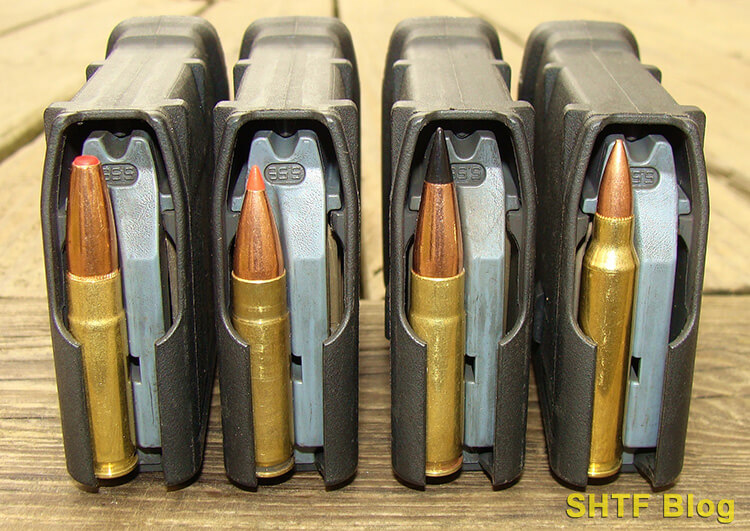
One problem, given Blackout’s giant unfold of bullet weights, is an acceptable rifling twist. Heavy and/or longer bullets in a given caliber require sooner twists. The lightest appropriate subsonic bullets are round 190-grains – nonetheless downright heavy for any .30-caliber. And 220s aren’t unusual.
To impart the steadiness vital for helpful accuracy, most .300 Blk barrels are rifled with quick 1:7, or 1:8 twists. These charges are a bit too fast for peak accuracy with gentle supersonics of 110-125 grains – the worth paid for compromise charges. The excellent news: Helpful bullet decisions will nonetheless be loads correct for many functions. Anticipate five-shot teams of lower than 1 ½-inches (1.5 MOA) at 100 yards with subs or supersonics. The larger hurdle is their disparate factors of influence (POIs).
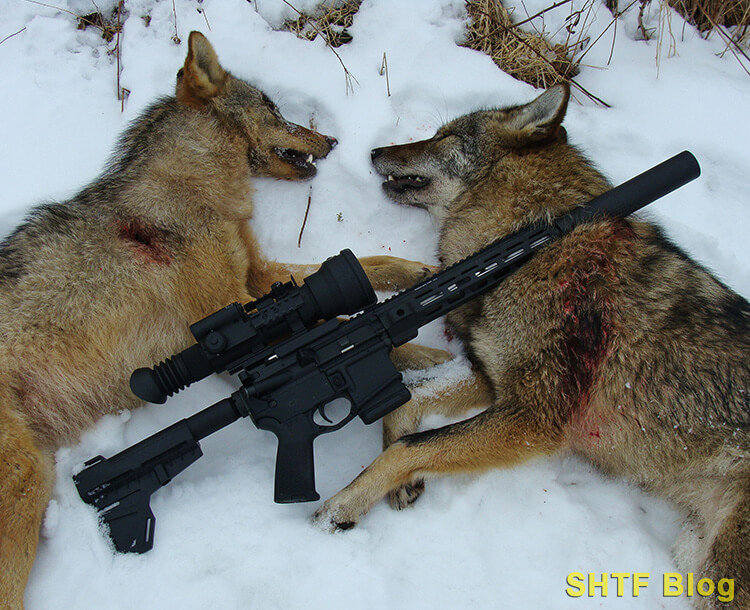
Subsonics
Most effectiveness of a silencer is simply attainable when bullets exit under the velocity of sound. As a result of temperature introduces variables, sonic cracks are greatest averted by muzzle velocities under 1100 fps. This raises issues about enlargement when utilizing ultra-heavy bullets vital for dependable AR-15 operate.
I achieved good accuracy and performance with Hornady 220-grain round-nose JSP handloads, however they’re actually designed for .30/06 velocities. The introduction of Hornady’s Subsonic 190-grain increasing SUB-X load was a welcome recreation changer – fairly actually.
This 1050 fps manufacturing unit load has quietly accounted for a lot of bobcats and huge jap coyotes, all shot inside 125 yards – the utmost sensible restrict for varmints because of the brick-like trajectories of all subs (see my article on coyote looking). From a 16-inch barrel, if zeroed at 100 yards, SUB-X strikes about 2 ½ inches excessive at 50 yards, and three ½” low at 125 yards.
Supersonics
These hundreds can wring out the Blackout’s full potential relating to trajectory and terminal results. The draw back is their supersonic crack – which can be a non-issue. For those who add suppressors, supersonics will sound just like high-speed .22 LRs (from a rifle) – extra tolerable than a naked muzzle. As for load preferences, some Blk afficionados shoot bullets as heavy as 150-grains (or extra) which, primarily based strictly on accuracy, make sense in fast rifling twists.
To flatten trajectory and enhance enlargement, I’ve settled on just a few lighter 110 – 120-grain bullets able to accuracy close to one-MOA. Hornady’s polymer-tipped 110 V-MAX will hammer (and exit) giant coyotes. This bullet may match for average-sized whitetails, however I’d reasonably play it secure with a more durable monolithic (solid-copper). The a number of folks in my looking circle have shot sufficient deer to achieve confidence in Barnes polymer-tipped 110 and 120-grain solid-copper TAC-TX bullets (all unrecovered pass-throughs).
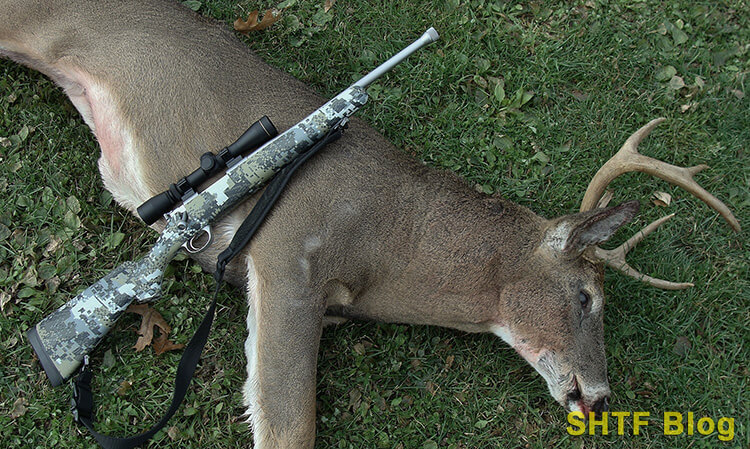
Both of the above 110-grain bullets may be pushed to 2350 fps from a 16-inch barrel. If zeroed 2-inches excessive at 100 yards, they’ll influence that quantity low at 200 yards – so far as I’d care to make use of this cartridge for humane outcomes. My 110s are all handloads, however my son shoots their manufacturing unit equivalents (utilizing Barnes 120-grain TAC-TX for deer). To achieve handier rifles most of those hundreds are fired by naked muzzles.
Impression Notes
If zeroed per above utilizing supersonics, subsonic .300 Blk hundreds can strike round a foot low at 100 yards! Overlook guesstimation. The higher answer is a scope with repeatable changes and/or a .300 Blk-specific reticle. Another choice: Collect your individual knowledge on a spread whereas utilizing a extra generic design.
Brief Barrels
As a result of the .300 Blk doesn’t burn a lot powder, it’s far more environment friendly than a caliber just like the 5.56 NATO. Via my suppressed 10 ½-inch AR-15 pistol, Hornady’s 190 SUB-X manages to clock 1025 fps; darned near its marketed velocity. Accuracy can also be near one-MOA, which comes as a aid.
My 220-grain subsonic handload key-holed terribly at 100 yards, elevating issues over baffle strikes. Conclusion: The 1:8 twist wasn’t quick sufficient to stabilize the heavy bullet in that pistol-length barrel. Thankfully, Hornady recommends that charge for his or her SUB-X load.
Extra Blackout Bennies
The .300 BLK caught on as a result of it fills distinctive niches. Past its capability to digest quiet subsonics in AR-15s, muzzle blast and recoil with supersonics is not more than a .223. Thus, it’s a sensible choice for brand spanking new or smaller shooters in a lot of firearms to incorporate single-shot rifles and bolt-actions. The extra .30-caliber punch can also be reassuring. The consequence of those positives has been the looks of quite a few firearms and helpful .300 Blk hundreds from mainstream producers.

Extra choices embody AR-15 upper-receiver assemblies and separate barrels. For individuals who wish to tinker, a conversion to .300 Blk requires nothing greater than a brand new barrel. With correct head-spacing, all the things else needs to be good to go. For probably the most half, this consists of magazines.
If utilizing hi-cap varieties, their inner vertical ribs can squeeze bigger stacks of stubby rounds inward by bullet contact. Some customers file down their polymer ribs, whereas others change to new .300 BLK mags. Or, for better versatility, simply pop the 2 pins in your AR-15’s decrease receiver and drop in one other pre-zeroed higher receiver meeting! You’ll have an instantaneous transformer able to firing .223/5.56 or .300 BLK rounds.
One warning although: To keep away from caliber mix-ups, take into account distinctive mags and labeled dust-covers!
Extending this technique additional, with a bucket stuffed with 5.56 brass and the right reloading gear, a virtually indefinite provide of economical fodder can be assured for both caliber. A complete .300 BLK cartridge-case is shorter than the straight-walled part of a .223/5.56 casing – however each share the identical .378” case-head and physique. I simply noticed off the necks of fired 5.56 instances and type my very own .300 Blk brass by operating them by a resizing die.
Regardless of these probably helpful benefits, the .300 Blackout isn’t (dare I say it?) a magic bullet.
Which One Ought to You Select?
As for the shopper within the gun store, like many different hunters who roam our woods with lever-guns and bolt-actions, these so-called “shortcomings” are of no concern. This fellow will likely be nicely served by the identical Winchester Mannequin 88 .308 lever-action that’s stuffed his freezer for the previous 5 a long time. However, time marches on others have completely different issues.
What if circumstances known as for just one rifle? Effectively, assuming each protection and subsistence looking had been necessities, geographics may dictate the selection. If attainable, I’d fudge it and go along with a 5.56 AR-15, whereas slipping in a spare higher receiver chambered for .300 Blackout.
As famous above, we’ve killed a bunch of deer with this caliber. Swapping uppers is as straightforward as popping the receiver pins, and each calibers are broadly distributed. Then once more, our terrain is closely forested. Ranges are brief and our greatest carnivores are black bears.
Western looking is a distinct matter. Open terrain and huge recreation name for extra energy and vary, so the nod goes to a .308. If harmful bears are a risk, even that caliber is sketchy. Get a much bigger gun, or cross your fingers and spring for heavy monolithic hundreds.
After all, a few of us endure the implications of obsessive firearms pursuits. These into blowing giant piles of money may wind up with rifles in every of those calibers. Of some comfort, if their muzzles occur to have 5/8×24 threads, attachment of QD adapters will allow using one .30-caliber suppressor.
